Abstract
Arguably, one of the most important requirement a building have to meet in case of fire is to ensure the safe evacuation of its users and the work of rescue teams. Consequently, issues related to the risks associated with falling parts of facades are fairly well known around Europe. Even though not equally well defined as other fire safety requirements concerning glazed facades, there is plenty of test methods for assessment of facades regarding falling parts, mostly based on an approach related to fire spread. In this paper selection of test method for assessment of facades regarding falling parts is briefly presented. However, focus of this work is on fire test of typical glazed segment of façade performed in ITB Laboratory. Results of the test positively verifies conjecture that solutions with glass units configured with thin, tempered glass panes on the outer side should pose no threat. However, the question has been raised whether the behaviour of other glass unit solutions (with additional coatings or laminated) would be similar.
1 Introduction
Because of its high aesthetics and ease of installation glazed façades are being increasingly used as the outer walls of modern buildings. Defined usually as curtain walls they provide the perfect climate baffle and adequate lighting for variety of facilities.
Façade is a type of wall which usually consists of vertical and horizontal structural members, connected together and fixed to the floor supporting structure of the building to form a lightweight space enclosing continuous skin, which provides, by itself or in conjunction with the building construction all the normal functions of the external wall but doesn’t take on any of the load bearing characteristics of the building. The walls of this type are performed frequently as the structural work in which the spaces between the metal profiles are filled with panes of clear or frosted glass. According to the current trends in contemporary architecture glazing, filling curtain walls should be of large dimensions. This is quite a challenge for both designers and contractors of glazed facades which besides eye catch look have to meet all normal functions of the non-load bearing exterior wall, including those related with fire safety.
The most important task building have to meet in case of fire is to ensure the safety of its users and rescue teams. Therefore the risk associated with the possibility of parts falling from the exterior wall in case of fire cannot be overlooked. For fire resistant façades, glazed with special glass panes this problem is arguably eliminated. In practice, more often, the fire resistance of the external wall is limited only to the spandrel areas, which allows the use of non-fire rated glass panes in the remaining space of the facade. This solution is sufficient to stop the spread of fire to adjacent floors of the building, but may pose certain risks associated with the possibility of large pieces of the façade falling. The problem is mainly related with the behavior of glass units under the influence of high temperature during a fire. Therefore ensuring the safety of evacuating users and rescue teams may also depends on the behavior of specified glazed unit fixing and structure. It is assumed that if, under the influence of fire, the outer layer of glass unit will break up into small pieces and fall down, it poses no threat. In opposition, if glass unit falls off as a whole (or in large, heavy pieces) then the danger is substantial.
Considering the above, the Fire Research Department of Building Research Institute (ITB) conducted the fire test of the façade specimen glazed with one of the typical, commonly used solution of glass units. The results of the test as well as the conclusions drawn from it are presented in this paper.
2 Fire safety requirements regarding glazed facades
According to the regulations implemented by many countries in certain types of buildings (e.g. hospitals, hotels, schools) as well as buildings with significant height [1,23], facades as a non-load bearing elements of building should be designed and constructed in such a way that in case of fire it will limit the spread of fire inside the building (to the adjacent floor or in specific cases adjacent room) and outside (to the adjacent buildings), allow the evacuation of users and ensure the safety of rescue team.
The above specified detailed requirements are not usually considered individually (e.g. ensuring proper evacuation is connected with the structural load bearing capacity, fire and smoke propagation within the building, and rescue team safety), therefore individual elements of buildings can play several roles during a fire.
This also refers to the building elements such as facades which are usually required in terms of design and execution to ensure that in case of fire they shall for a specific period of time prevent its development between the adjacent floors or rooms of the building and between the adjacent objects. Moreover the fixing of the curtain walls shall be made in a way that prevents falling of the parts of element during the evacuation and rescue team activities.
The problem connected with possibility of fire propagation to the adjacent floors is usually solved by designing a fire resistant spandrel [4] of an appropriate height in floor area. The height of the spandrel depends on the regulations in the specific country, but it is usually about 0,8 up to 1,2 m. To stop the fire propagation to the other floors it is also very important to use in the construction of façade materials with proper reaction to fire class and limiting the spread of fire. Glass facade is the weakest part in the building envelope and can be broken easily when exposed to a big fire. This can create an inlet for hot gases into the room from the outside, resulting in the fire in the compartment spreading to other floors or rooms [5, 6]. This is not a major issue for the typical glazed facades with properly made spandrel area, because the metal (steel or aluminum) profiles and glazing are non-combustible materials, thus the possibility of fire propagation is limited only to the glazing gaskets and thermal separators placed between the profiles and glazing fixing. Fortunately, these elements constitute a small percentage of the facade surface and therefore the risk that the fire will spread by them to an adjacent floor is negligible.
In some cases the façade has to be prepared in a such way that stops the spread of fire to adjoining room. Sometimes a facade, the outer skin of the building is combined with the inner walls, which are forming the fire separation. In this situation it is very important to properly seal the linear joint [7, 8] between the external and internal barriers.
Reducing the spread of fire to adjacent buildings is solved by preserving the appropriate distances between buildings or if this is not possible through the use of special façade of a specific fire resistance class. Glazed curtain walls with a specific fire resistance class are usually made as mullion – transom structures in which the areas between the aluminium or steel profiles are filled with fire resistant glass units. The load bearing members in those structures are mullions, typically in the form of box section profiles (commonly with additional reinforcement – steel or aluminium stiffening profiles) [9]. In order to improve thermal insulation, the profiles are also filled with special insulating inserts. Material of the inserts as well as the filling volume is dependent on the destination to use for the specific class of fire resistance of the curtain wall. The materials used for insulation inserts are usually gypsum plasterboards, silicate - cement or silicate – calcium [10. The glazing as well as solution of profile insulation is selected depending on the expected fire resistance class of the curtain wall. The most commonly used in practice are glass units comprising a fireproof glass (tempered glass panes divided by the special gel or foil expanding under the influence of high temperature) coupled with the outer glass pane. Glass units are usually fixed in the curtain wall by means of pressure plates screwed to the main aluminium profile [11]. The solution of the glazing fixing method has a key role in achieving the appropriate fire resistance class especially in the case of increasingly common glass units of large dimensions [12,13, 14].
The fire resistant facades are also the best solution to ensure the safety of evacuating people and rescue team, but as it was written before the fire resistant barrier is in many cases placed only in the spandrel area and whole space between the spandrels is glazed with non-fire resistant glass panes. This situation causes the necessity of consideration the risks connected with the falling parts of the facade. The compulsion to ensure safety of people evacuating from the building and members of rescue teams in case of fire is one of the essential requirement concerning fire safety [15,16,17,18, 19]. Therefore this requirement also shall apply to the risk associated with the possibility of parts falling from the exterior wall in case of fire. It is worth emphasizing, that the requirement applies not only to fire resistant parts of facade, but practically to the entire exterior wall of every construction work.
3 Methods of fire safety assessment regardING falling parts of external walls
Currently in Europe, assessments of facades regarding falling parts are based on test methods which use approach related to fire spread. Tests performed in laboratories in Sweden, Germany, Austria or Hungary use various types of fuels to create a heating through the openings that usually imitates the window. All these methods also allows examination of the problem of falling parts of facades, though due to large diversity of measured values and evaluation criteria and lack of clear criterion for falling parts alone make quantitative assessment really problematic.
3.1 Polish (ITB) test method of testing and assessment of building façades with regard to falling parts of external wall claddings in case of fire [18]
ITB test method was developed based on analysis of foreign standards and testing procedures in the similar fields and consultations with the National Headquarters of the Fire Service with regard to correct assessment criteria in the light of the national regulations. Impact on facade is assumed in the form of flames, generated from a specially designed propane burner with a defined temperature and height of the flame. In this method, fully developed fire in apartment is only simulated – perfectly repeatable, well defined flame temperature refers to standardized internal exposure curve. On the level of fire chamber an opening (window simulation) dimensions of 2,00 × 1,20 m (width × height) is made. Observations are subjected to the weight of falling pieces that are weighted immediately if possible or their weight is estimated based on the observation and calculations.
3.2 Hungarian test method (MSZ 14800-6:2009) [19]
Hungarian test method (MSZ 14800-6:2009) is based on of fire propagation on building façades philosophy. It’s suitable for both ETICS or cladding systems. In this method, fully developed fire is induced in the test chamber (using fuel of timber cribs) – obtained temperature refers to standardized internal exposure curve. On the level of fire chamber an openable window dimensions of 1,20 × 1,20 m is installed. Observations are subjected to height and width of the flames and weight of the falling pieces.
3.3 Swedish test method (SP Fire 105) [20]
Swedish test method (SP Fire 105), valid also in Denmark and Norway, is based on fire propagation on building façades approach. Similar to Hungarian test method fire scenario represent flames surges out of the apartment window (dimensions of 1,51 × 1,20 m, width × height) placed on the level of fire chamber imitating an apartment overwhelmed with fully developed fire. It’s suitable for all kinds of cladding systems. Observations are subjected to height and width of the flames (also temperature below the eaves) and falling of major parts of facades such as large pieces of plaster, panels or glass panes, that could cause danger to people evacuating or to rescue personnel.
3.4 Test method in USA (NFPA 285) [20, 21]
However rather not used in Europe, NFPA 285 (USA) test procedure is also worth mentioning. NFPA 285 is a Standard Fire Test Method for Evaluation of Fire Propagation Characteristics of Exterior Non-Load-Bearing Wall Assemblies. It’s used for fire propagation assessment of various combustible claddings systems, with similar to European test methods fire scenario (though with gas as fire load) but does not requires examining of the falling parts phenomenon.
4 Fire test of glazed façade with non-fire glazing
Due to the fact that the above assessment methods applies mainly to non –glazed solutions it would not be appropriate to use any of them to evaluate the phenomenon, which is the subject of the paper. All test methods described above represents the approach of fire exposure after the glazing in outer wall (substantially simple window) has been damaged. The purpose of the test described in this paper was, however, to check the way of that damage when it occurs. Therefore in order to reflect the actual conditions on which the glass façade will be exposed in real fire scenario it was necessary to apply a slightly different approach based on fire resistance test methodology. Obviously one could just fix few segments of glazed facade above the window, and subject it to flame heating, although such scenario is blatantly less dangerous in terms of possibility of large parts of glass falling compared to internal heating.
4.1 Test specimen and supporting construction
The test specimen dimensions of 2014 × 3883 mm (width × height) had mullion transom structure. It was made of façade system aluminum profiles - four mullions (2 pcs. on the edges and 2 pcs. inside) and six transoms (3 pcs. placed along the bottom side and 3 pcs. placed along the top side) forming 3 areas. The side areas were filled with opaque panels made of aluminum sheet and mineral wool and the most important from the study view central area was filled with two-chamber glass unit dimensions of 1350 × 3800 × 59 mm (width × height × overall thickness). Glass unit was made of (layers from the inside): laminated VSG 5.5.2 glass pane thickness of 10,76 mm, air gap 18 mm (steel frame on the glass unit perimeter), ESG 6 mm tempered glass pane, air gap 16 mm (steel frame on the glass unit perimeter), ESG 8 mm tempered glass pane. The glass pane was mechanically fixed to the aluminum profiles by means of four steel angles (2 pcs. per side edge). Additionally glass pane was fixed by means of special structural silicone placed on the perimeter. The test specimen was fixed by steel anchors to the supporting construction made of aerated concrete blocks thickness of 240 mm (on the side edges) and reinforced concrete beams cross-section of 240 × 240 mm (bottom and top). General view of test specimen is presented in Fig. 4 (drawing), Fig. 6 (photo of the exposed and unexposed surface prior to the test).
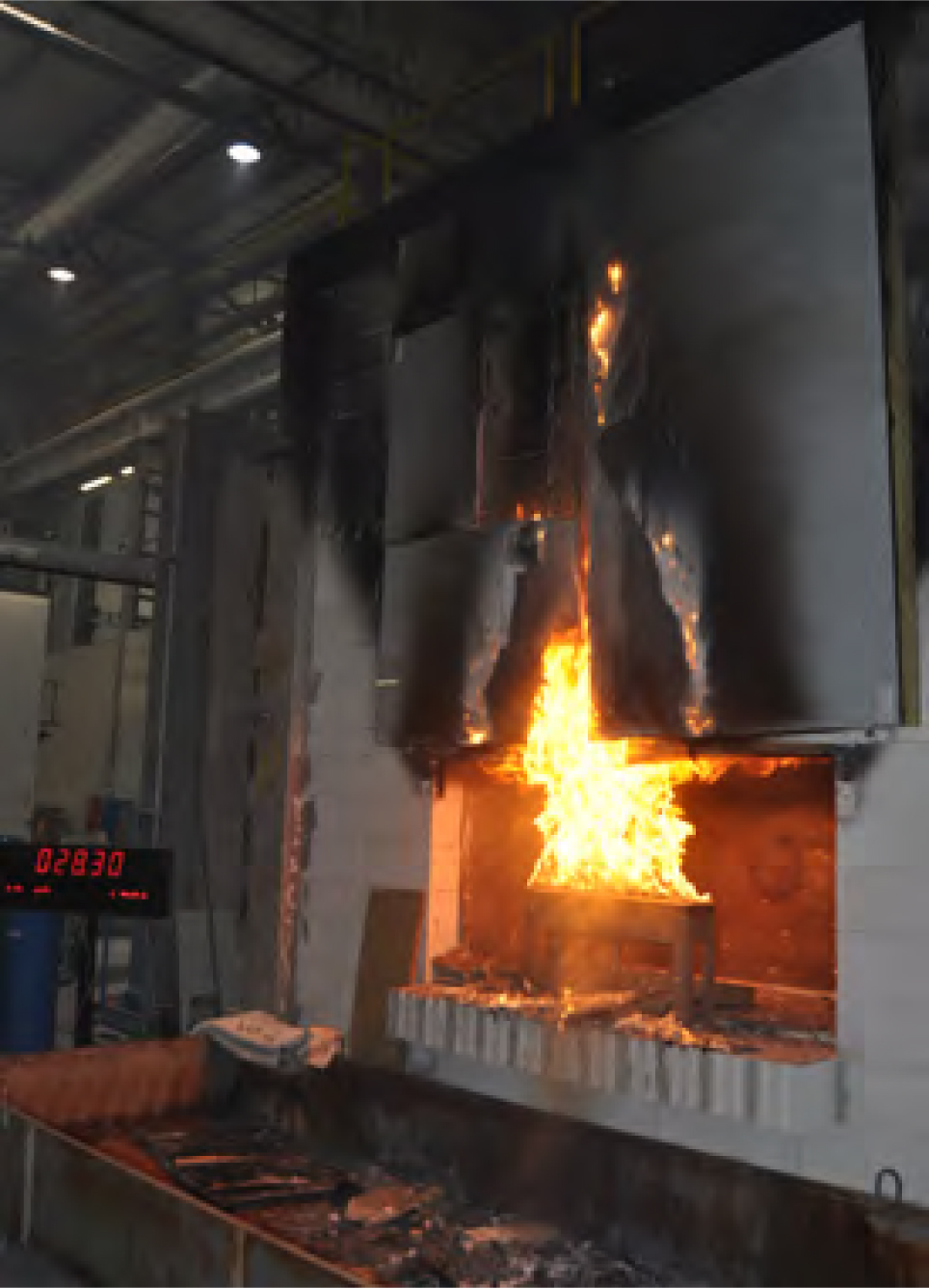
Example of fire test acc. to ITB procedure.
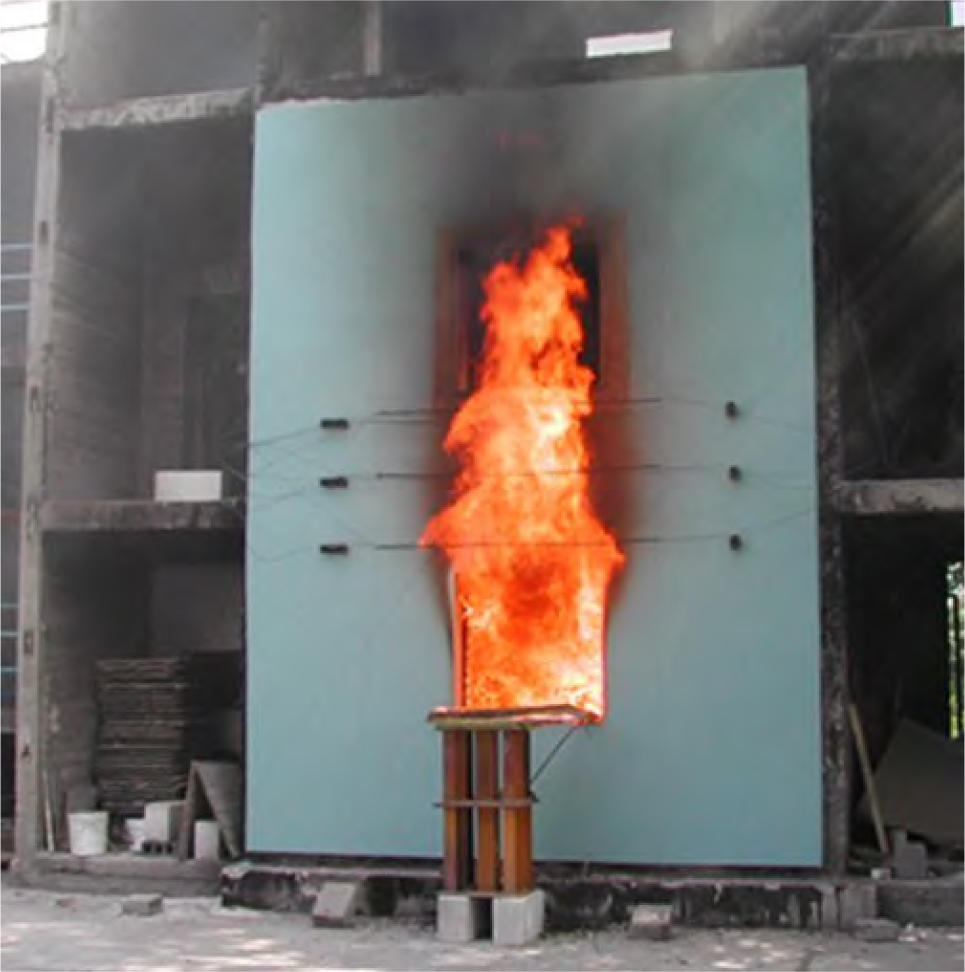
Example of fire test acc. to MSZ 14800-6:2009 procedure.
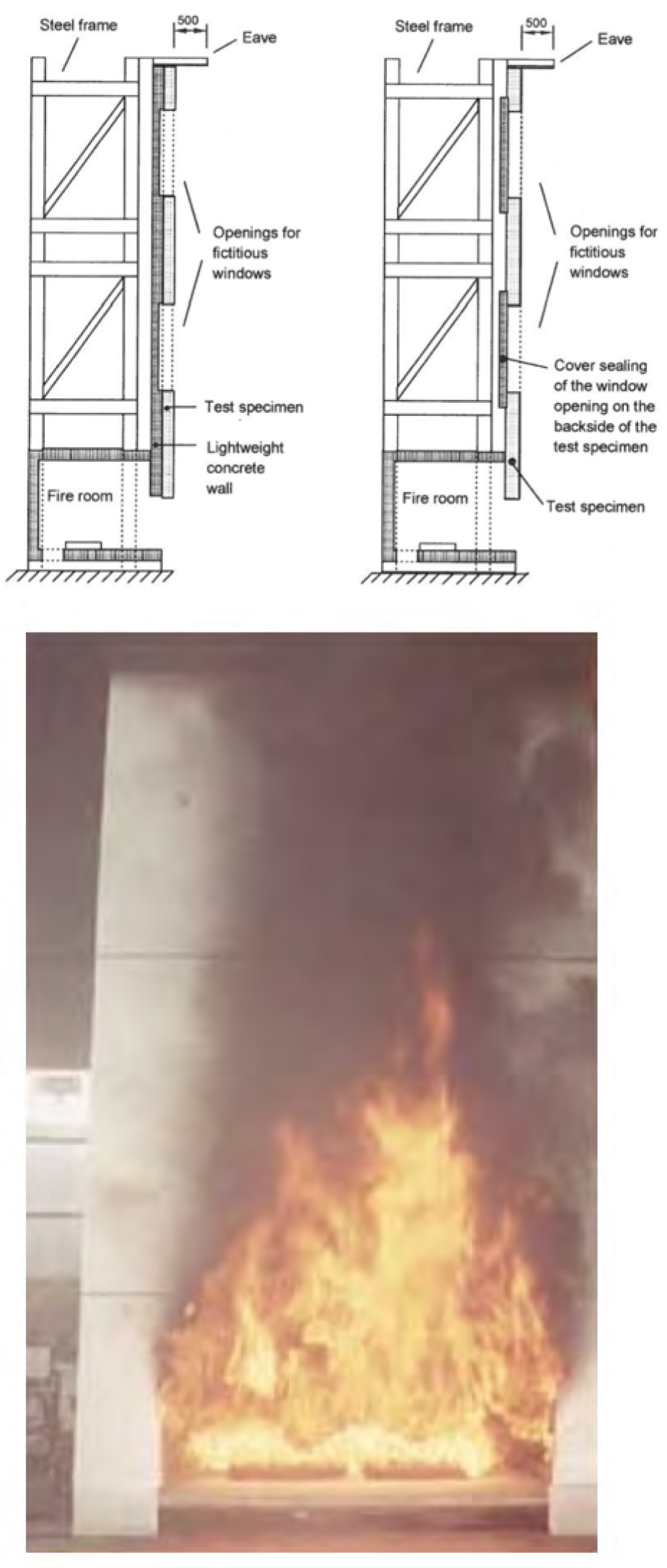
Example of fire test acc. to SP Fire 105 procedure.
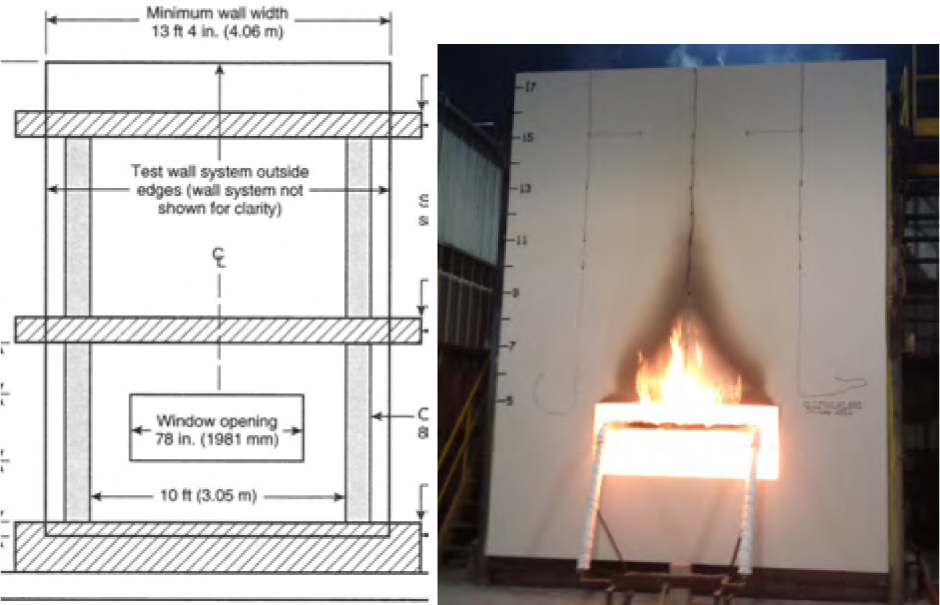
Example of fire test acc. to NFPA 285 procedure.
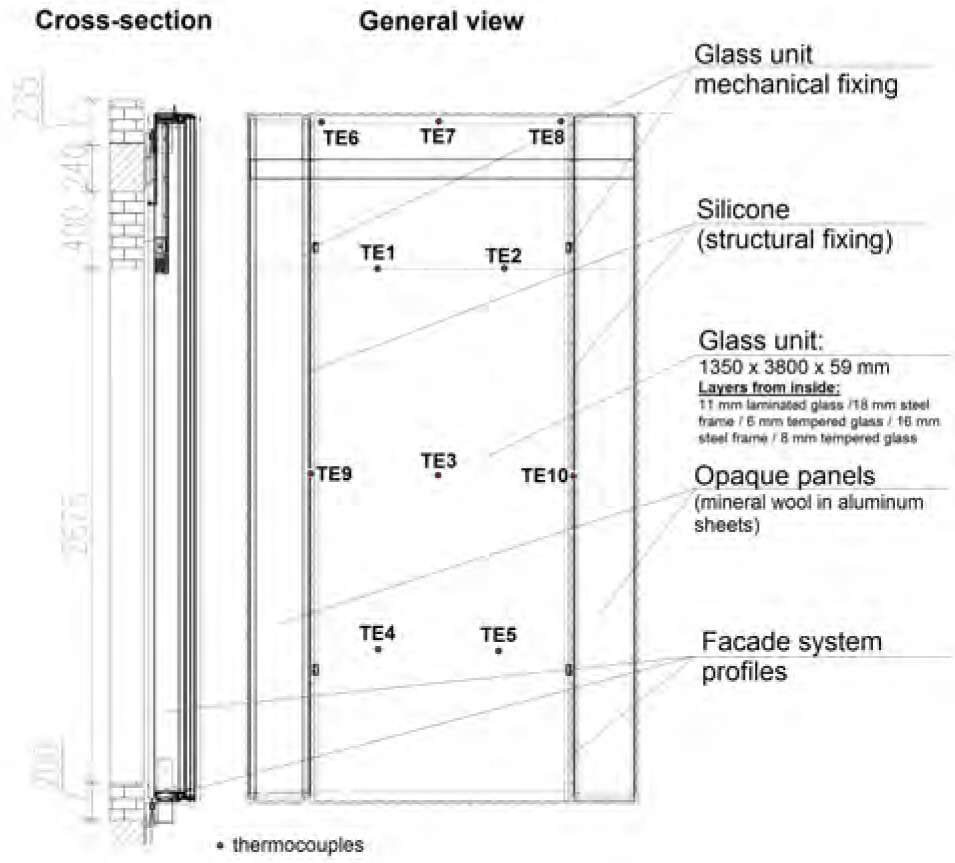
General view of tested specimen with location of thermocouples.

The view of the exposed (left side) and unexposed (right side) surface of tested specimen prior to the test.
4.2 Test equipment and conditions
The test specimen and supporting construction was fixed to the front of the special testing furnace with opening dimensions of 3,7 × 3,7 m and depth of 1,5 m with ceramic walls. Furnace was equipped with 8 natural gas burners placed on the side walls (4 pcs. per side), with overall power of 2,7 MW.
The assumption of the study was to check the behavior of the glass pane in case of fire which can develop inside the building, therefore it was decided that the best option to reflect those conditions will be to heat the furnace in accordance with standard temperature-time curve, defined by the equation (1) below:
The temperature inside the furnace was measured by means of 16 evenly placed plate thermometers comprised of an assembly of folded nickel alloy plate, a thermocouple fixed to it and insulation material. The average temperature inside the furnace during the test is presented in Fig. 7.
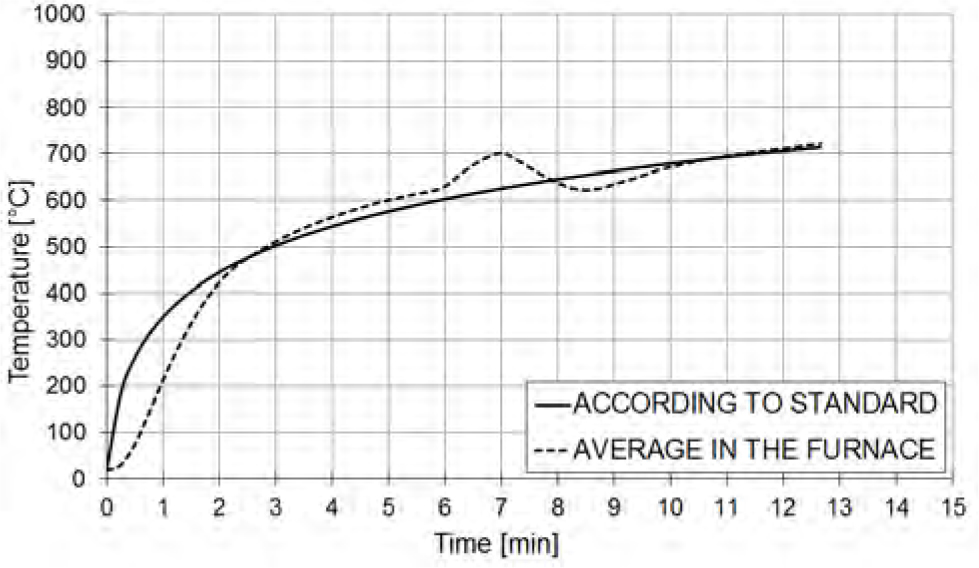
Temperature/time graph of furnace heating conditions (solid line – standard temperature-time curve, dashed line – average temperature inside the furnace).
On the unexposed surface of tested specimen temperature was measured by means of surface thermocouples (type K as specified in EN 1363-1, with copper disc diameter of 12 mm).
4.3 Test results
The test lasted 12 minutes and 39 seconds and was finished after the failure of the external glass pane layer.
During the conducted fire test temperature rises were measured on the unexposed surface of the glass pane and structural silicone in the places presented in Fig. 1. The results of the measurements are presented in Fig. 8 – 11.
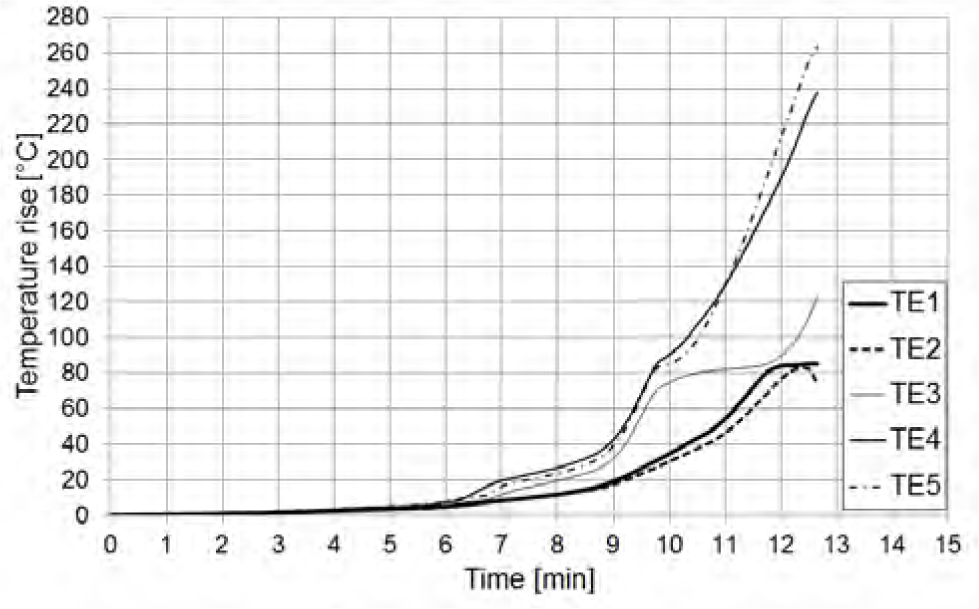
Graph of the temperature rises on unexposed surface of glass unit (thermocouples placed in the quarter of the glass unit and in the glass unit center).
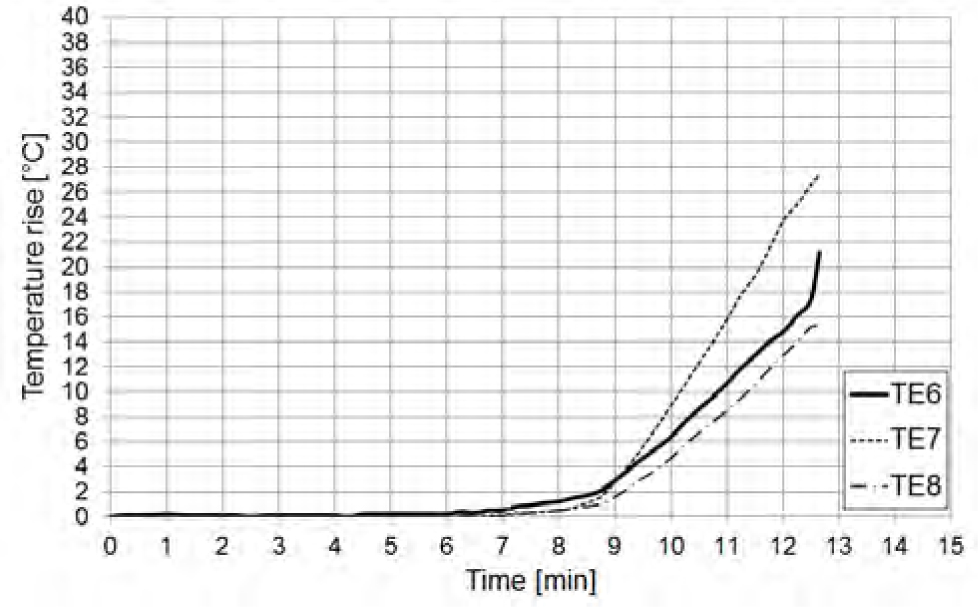
Graph of the temperature rises on unexposed surface of glass unit (thermocouples placed in the top of the glass unit).
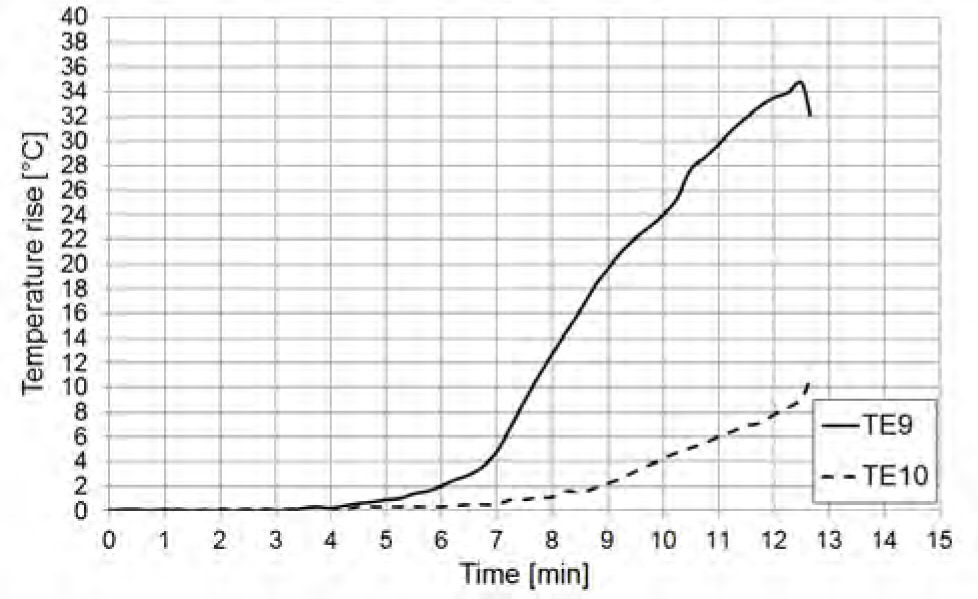
Graph of the temperature rises on unexposed surface of structure silicone.
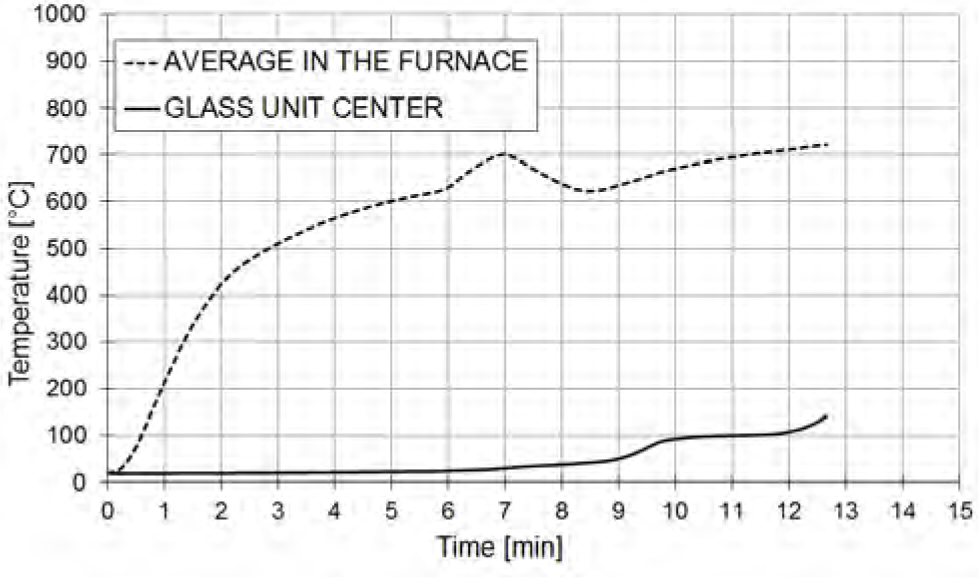
The comparison of the temperature inside the furnace and in the center of the glass unit.
The most important from the point of view of the assumptions made prior to the test were observations concerning the behavior of glass unit and more specifically the way in which it will be damaged due to the impact of fire. In the end of 5th minute of the test the layers of laminated inside glass pane starts to uncoupling, what is presented in Fig. 12a. Subsequently glass started to crack and fell into the furnace in 7th minute of the test (Fig. 12b). Fragments of the internal glazing falling off in considerable pieces but did not cause the damage to another glass pane layer. The second glass pane, which was first of the tempered ones has been cracked in the beginning of 11th minute of the test. The layer cracked on the small pieces and fall down into the furnace (Fig. 12c). Subsequently, the outer glass pane (last layer of glass unit) under the influence of high temperature starts to deform, what was especially visible in the bottom corners moved in direction outside the furnace (Fig. 12d, e). Finally in the 12’ 39” of the test the outer layer of the glass unit cracked on small pieces and fall down partially inside and partially outside the furnace chamber (Fig. 12f).
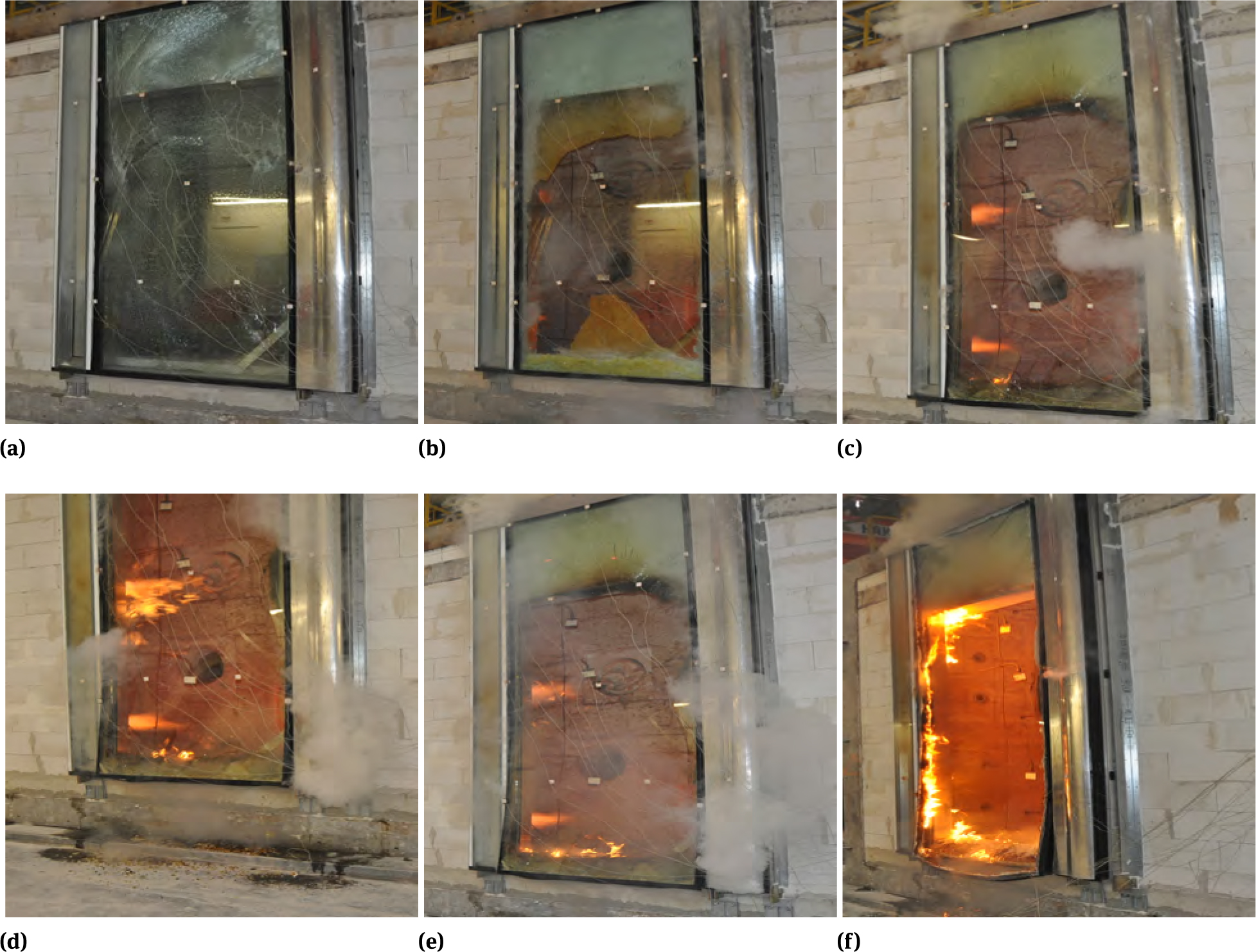
The view of the unexposed surface of tested specimen: a) in 4’50” of the test; b) in 6’49”of the test; c) in 10’04”of the test, d) in 12’27”of the test; e) in 12’29”of the test; f) after the test.
In the Fig. 8 it can be observed that temperature rises on top of the glass pane (TE 1, TE 2) were significantly lower than others, probably due to close to lintel positioning.
In the Fig. 10 it can be observed that temperature rises on outer silicone on the left side of the test element were greater than those on the other side – this effect could have been caused by silicone damage during falling of first layer of the glass unit.
Moreover it can be observed that temperature rises on unexposed side of glass panes rapidly rises during 6 – 7 min, 9 – 10 min, and in 12th minute of the test and after first and second rapid rises there was a period of time when the temperature rise is very low. This phenomenon is directly connected with falling of each layer of the glass unit.
5 Conclusions
Test results indicate that solutions with glass units configured with thin, tempered glass panes on the outer side have great chance to meet the “ensure the safety of its users and rescue teams” requirement, namely crack into small pieces. However, glass pane fixing method (materials, fixing points spacing and positioning) is also very important to prevent glass panes to slip out of the profile before they will crack. As it was observed after the falling off the second layer of the glass pane the last one starts to bend causing the deformation on the bottom edges. This kind of deformation in case of other fixing solution could cause fall out whole outer layer of the glass unit.
Another, even more significant, factor is the type of the glass pane itself. There are no clear research evidence, that other kinds of commonly used glass panes would act the same. Additional coating applied to modify its characteristics (e.g. special reflection/acoustic/transmission/absorption properties) or whole range of different laminated glass panes may not necessarily break into small fragments. There is also a risk that all the small pieces may remain on the foil that has not burn out.
Furthermore it is unclear how glazed façade would behave in case of other fire curve scenarios. Therefore increase in number of such targeted studies for different types of popular glazed units is advisable.
References
[1] A. Glass and A. I. Rubin, “Fire safety for high-rise buildings,” Gaithersburg, MD, 1979. 10.6028/NBS.BSS.115.Search in Google Scholar
[2] P. Sulik, B. Sędłak, P. Turkowski, and W. Węgrzyński,“Bezpieczeństwo pożarowe budynków wysokich i wysokościowych,” in Budownictwo na obszarach zurbanizowanych, Nauka, praktyka, perspektywy, A. Halicka, Ed. Politechnika Lubelska, 2014, pp. 105–120.Search in Google Scholar
[3] S. Sassi, P. Setti, G. Amaro, L. Mazziotti, G. Paduano, P. Cancelliere, and M. Madeddu, “Fire safety engineering applied to high-rise building facades,” MATEC Web Conf., vol. 46, p. 04002, May 2016. 10.1051/matecconf/20164604002.Search in Google Scholar
[4] B. Sędłak and P. Sulik, “Odporność ogniowa pasów międzykondygnacyjnych aluminiowo-szklanych ścian osłonowych,” Izolacje, vol. 21, no. 1, pp. 66–73, 2016.Search in Google Scholar
[5] A. Kolbrecki, “Model of fire spread out on outer building surface,” Bull. Polish Acad. Sci. Tech. Sci., vol. 63, no. 1, pp. 135–144, 2015. 10.1515/bpasts-2015-0015.Search in Google Scholar
[6] C. L. Chow and W. K. Chow, “Experimental Studies on Fire Spread Over Glass Façade,” in Volume 5: Energy Systems Analysis, Thermodynamics and Sustainability; NanoEngineering for Energy; Engineering to Address Climate Change, Parts A and B, 2010, pp. 415–422. 10.1115/IMECE2010-37363.Search in Google Scholar
[7] Z. Laskowska and A. Borowy, “Złącza liniowe – rozwiązania, badania i klasyfikacja w zakresie odporności ogniowej,” Mater. Bud., vol. 1, no. 7, pp. 2–5, 2013.Search in Google Scholar
[8] B. Sędłak and P. Roszkowski, “Izolacyjność ogniowa uszczelnień złączy liniowych w zależności od głębokości i szerokości złącza,” Izolacje, vol. 20, no. 10, pp. 58–63, 2015.Search in Google Scholar
[9] P. Sulik, B. Sędłak, and J. Kinowski, “Study on critical places for maximum temperature rise on unexposed surface of curtain wall test specimens,” in MATEC Web of Conferences, 2016, vol. 46, p. 02006. 10.1051/matecconf/20164602006.Search in Google Scholar
[10] J. Kinowski, B. Sędłak, and P. Sulik, “Izolacyjność ogniowa aluminiowo - szklanych ścian osłonowych w zależności od sposobu wypełnienia profili szkieletu konstrukcyjnego,” Izolacje, vol. 20, no. 2, pp.48–53, 2015.Search in Google Scholar
[11] P. Sulik, J. Kinowski, and B. Sędłak, “FIRE RESISTANCE OF ALUMINIUM GLAZED CURTAIN WALLS, Test results comparison depending on the side of fire exposure,” Appl. Struct. Fire Eng., Jan. 2016. 10.14311/asfe.2015.076.Search in Google Scholar
[12] B. Sędłak, J. Kinowski, and A. Borowy, “Fire resistance tests of large glazed aluminium curtain wall test specimens - Results comparison,” in MATEC Web of Conferences, 2013, vol. 9, p. 02009. 10.1051/matecconf/20130902009Search in Google Scholar
[13] B. Sędłak and P. Sulik, “Odporność ogniowa wielkogabarytowych pionowych elementów przeszklonych,” Mater. Bud., vol. 1, no. 7, pp. 28–30, Jul. 2015. 10.15199/33.2015.07.06.Search in Google Scholar
[14] J. Kinowski, B. Sędłak, and P. Sulik, “Large glazing in curtain walls - Study on impact of fixing methods on fire resistance,” in MATEC Web of Conferences, 2016, vol. 46, p. 05004. 10.1051/matecconf/20164605004.Search in Google Scholar
[15] W. K. Chow, Y. Gao, and C. L. Chow, “A Review on Fire Safety in Buildings with Glass Façade,” J. Appl. Fire Sci., vol. 16, no. 3, pp. 201–223, Jan. 2006. 10.2190/AF.16.3.b.Search in Google Scholar
[16] J. Kinowski and P. Sulik, “Bezpieczeństwo użytkowania elewacji,” Mater. Bud., vol. 9, pp. 38–39, 2014.Search in Google Scholar
[17] P. Sulik and B. Sędłak, “Bezpieczeństwo pożarowe przeszklonych elewacji,” Mater. Bud., vol. 1, no. 9, pp. 20–22, Sep. 2015. 10.15199/33.2015.09.04.Search in Google Scholar
[18] J. Kinowski, B. Sędłak, and P. Sulik, “Falling parts of external walls claddings in case of fire - ITB test method - Results comparison,” in MATEC Web of Conferences, 2016, vol. 46, p. 02005. 10.1051/matecconf/20164602005.Search in Google Scholar
[19] I. Móder, Á. Varga, P. Geier, B. Vágó, and E. Rajna, “Brief summary of the Hungarian test method (MSZ 14800-6:2009) of fire propagation on building façades,” MATEC Web Conf., vol. 46, p. 01002, May 2016. 10.1051/matecconf/20164601002.Search in Google Scholar
[20] J. Anderson and R. Jansson, “Façade fire tests – measurements and modeling,” MATEC Web Conf., vol. 9, p. 2003, 2013. 10.1051/matecconf/20164603002.Search in Google Scholar
[21] M. Smolka, B. Messerschmidt, J. Scott, and B. le Madec, “Semi-natural test methods to evaluate fire safety of wall claddings,” MATEC Web Conf., vol. 9, p. 02012, Nov. 2013. 10.1051/matecconf/20130902012.Search in Google Scholar
[22] M. Smolka, E. Anselmi, T. Crimi, B. Le Madec, I. F. Móder, K. W. Park, R. Rupp, Y.-H. Yoo, and H. Yoshioka, “Semi-natural test methods to evaluate fire safety of wall claddings: Update,” MATEC Web Conf., vol. 46, pp. 01003–11, 2016. 10.1051/matecconf/20130902012.Search in Google Scholar
Nomenclature Listing
- t
time (min)
- T
temperature (°C)
© 2018 Bartłomiej Sędłak et al.
This work is licensed under the Creative Commons Attribution-NonCommercial-NoDerivatives 4.0 License.
Articles in the same Issue
- Regular Article
- Real-scale comparison between simple and composite raw sewage sampling
- 10.1515/eng-2018-0017
- The risks associated with falling parts of glazed facades in case of fire
- Implementation of high speed machining in thin-walled aircraft integral elements
- Evaluating structural crashworthiness and progressive failure of double hull tanker under accidental grounding: bottom raking case
- Influence of Silica (SiO2) Loading on the Thermal and Swelling Properties of Hydrogenated-Nitrile-Butadiene-Rubber/Silica (HNBR/Silica) Composites
- Statistical Variations and New Correlation Models to Predict the Mechanical Behavior and Ultimate Shear Strength of Gypsum Rock
- Analytic approximate solutions to the chemically reactive solute transfer problem with partial slip in the flow of a viscous fluid over an exponentially stretching sheet with suction/blowing
- Thermo-mechanical behavior simulation coupled with the hydrostatic-pressure-dependent grain-scale fission gas swelling calculation for a monolithic UMo fuel plate under heterogeneous neutron irradiation
- Optimal Auxiliary Functions Method for viscous flow due to a stretching surface with partial slip
- Vibrations Analysis of Rectangular Plates with Clamped Corners
- Evaluating Lean Performance of Indian Small and Medium Sized Enterprises in Automotive Sector
- FPGA–implementation of PID-controller by differential evolution optimization
- Thermal properties and morphology of polypropylene based on exfoliated graphite nanoplatelets/nanomagnesium oxide
- A computer-based renewable resource management system for a construction company
- Hygrothermal Aging of Amine Epoxy: Reversible Static and Fatigue Properties
- The selected roof covering technologies in the aspect of their life cycle costs
- Influence of insulated glass units thickness and weight reduction on their functional properties
- Structural analysis of conditions determining the selection of construction technology for structures in the centres of urban agglomerations
- Selection of the optimal solution of acoustic screens in a graphical interpretation of biplot and radar charts method
- Subsidy Risk Related to Construction Projects: Seeking Causes
- Multidimensional sensitivity study of the fuzzy risk assessment module in the life cycle of building objects
- Planning repetitive construction projects considering technological constraints
- Identification of risk investment using the risk matrix on railway facilities
- Comparison of energy parameters of a centrifugal pump with a multi-piped impeller in cooperation either with an annular channel and a spiral channel
- Influence of the contractor’s payment method on the economic effectiveness of the construction project from the contractor’s point of view
- Special Issue Automation in Finland
- Diagnostics and Identification of Injection Duration of Common Rail Diesel Injectors
- An advanced teaching scheme for integrating problem-based learning in control education
- A survey of telerobotic surface finishing
- Wireless Light-Weight IEC 61850 Based Loss of Mains Protection for Smart Grid
- Smart Adaptive Big Data Analysis with Advanced Deep Learning
- Topical Issue Desktop Grids for High Performance Computing
- A Bitslice Implementation of Anderson’s Attack on A5/1
- Efficient Redundancy Techniques in Cloud and Desktop Grid Systems using MAP/G/c-type Queues
- Templet Web: the use of volunteer computing approach in PaaS-style cloud
- Using virtualization to protect the proprietary material science applications in volunteer computing
- Parallel Processing of Images in Mobile Devices using BOINC
- “XANSONS for COD”: a new small BOINC project in crystallography
- Special Issue on Sustainable Energy, Engineering, Materials and Environment
- An experimental study on premixed CNG/H2/CO2 mixture flames
- Tidal current energy potential of Nalón river estuary assessment using a high precision flow model
- Special Spring Issue 2017
- Context Analysis of Customer Requests using a Hybrid Adaptive Neuro Fuzzy Inference System and Hidden Markov Models in the Natural Language Call Routing Problem
- Special Issue on Non-ferrous metals and minerals
- Study of strength properties of semi-finished products from economically alloyed high-strength aluminium-scandium alloys for application in automobile transport and shipbuilding
- Use of Humic Sorbent from Sapropel for Extraction of Palladium Ions from Chloride Solutions
- Topical Issue on Mathematical Modelling in Applied Sciences, II
- Numerical simulation of two-phase filtration in the near well bore zone
- Calculation of 3D Coordinates of a Point on the Basis of a Stereoscopic System
- The model of encryption algorithm based on non-positional polynomial notations and constructed on an SP-network
- A computational algorithm and the method of determining the temperature field along the length of the rod of variable cross section
- ICEUBI2017 - International Congress on Engineering-A Vision for the Future
- Use of condensed water from air conditioning systems
- Development of a 4 stroke spark ignition opposed piston engine
- Development of a Coreless Permanent Magnet Synchronous Motor for a Battery Electric Shell Eco Marathon Prototype Vehicle
- Removal of Cr, Cu and Zn from liquid effluents using the fine component of granitic residual soils
- A fuzzy reasoning approach to assess innovation risk in ecosystems
- Special Issue SEALCONF 2018
- Brush seal with thermo-regulating bimetal elements
- The CFD simulation of the flow structure in the sewage pump
- The investigation of the cavitation processes in the radial labyrinth pump
- Testing of the gaskets at liquid nitrogen and ambient temperature
- Probabilistic Approach to Determination of Dynamic Characteristics of Automatic Balancing Device
- The design method of rubber-metallic expansion joint
- The Specific Features of High-Velocity Magnetic Fluid Sealing Complexes
- Effect of contact pressure and sliding speed on the friction of polyurethane elastomer (EPUR) during sliding on steel under water wetting conditions
- Special Issue on Advance Material
- Effect of thermo-mechanical parameters on the mechanical properties of Eurofer97 steel for nuclear applications
- Failure prediction of axi-symmetric cup in deep drawing and expansion processes
- Characterization of cement composites based on recycled cellulosic waste paper fibres
- Innovative Soft Magnetic Composite Materials: Evaluation of magnetic and mechanical properties
- Statistical modelling of recrystallization and grain growth phenomena in stainless steels: effect of initial grain size distribution
- Annealing effect on microstructure and mechanical properties of Cu-Al alloy subjected to Cryo-ECAP
- Influence of heat treatment on corrosion resistance of Mg-Al-Zn alloy processed by severe plastic deformation
- The mechanical properties of OFHC copper and CuCrZr alloys after asymmetric rolling at ambient and cryogenic temperatures
Articles in the same Issue
- Regular Article
- Real-scale comparison between simple and composite raw sewage sampling
- 10.1515/eng-2018-0017
- The risks associated with falling parts of glazed facades in case of fire
- Implementation of high speed machining in thin-walled aircraft integral elements
- Evaluating structural crashworthiness and progressive failure of double hull tanker under accidental grounding: bottom raking case
- Influence of Silica (SiO2) Loading on the Thermal and Swelling Properties of Hydrogenated-Nitrile-Butadiene-Rubber/Silica (HNBR/Silica) Composites
- Statistical Variations and New Correlation Models to Predict the Mechanical Behavior and Ultimate Shear Strength of Gypsum Rock
- Analytic approximate solutions to the chemically reactive solute transfer problem with partial slip in the flow of a viscous fluid over an exponentially stretching sheet with suction/blowing
- Thermo-mechanical behavior simulation coupled with the hydrostatic-pressure-dependent grain-scale fission gas swelling calculation for a monolithic UMo fuel plate under heterogeneous neutron irradiation
- Optimal Auxiliary Functions Method for viscous flow due to a stretching surface with partial slip
- Vibrations Analysis of Rectangular Plates with Clamped Corners
- Evaluating Lean Performance of Indian Small and Medium Sized Enterprises in Automotive Sector
- FPGA–implementation of PID-controller by differential evolution optimization
- Thermal properties and morphology of polypropylene based on exfoliated graphite nanoplatelets/nanomagnesium oxide
- A computer-based renewable resource management system for a construction company
- Hygrothermal Aging of Amine Epoxy: Reversible Static and Fatigue Properties
- The selected roof covering technologies in the aspect of their life cycle costs
- Influence of insulated glass units thickness and weight reduction on their functional properties
- Structural analysis of conditions determining the selection of construction technology for structures in the centres of urban agglomerations
- Selection of the optimal solution of acoustic screens in a graphical interpretation of biplot and radar charts method
- Subsidy Risk Related to Construction Projects: Seeking Causes
- Multidimensional sensitivity study of the fuzzy risk assessment module in the life cycle of building objects
- Planning repetitive construction projects considering technological constraints
- Identification of risk investment using the risk matrix on railway facilities
- Comparison of energy parameters of a centrifugal pump with a multi-piped impeller in cooperation either with an annular channel and a spiral channel
- Influence of the contractor’s payment method on the economic effectiveness of the construction project from the contractor’s point of view
- Special Issue Automation in Finland
- Diagnostics and Identification of Injection Duration of Common Rail Diesel Injectors
- An advanced teaching scheme for integrating problem-based learning in control education
- A survey of telerobotic surface finishing
- Wireless Light-Weight IEC 61850 Based Loss of Mains Protection for Smart Grid
- Smart Adaptive Big Data Analysis with Advanced Deep Learning
- Topical Issue Desktop Grids for High Performance Computing
- A Bitslice Implementation of Anderson’s Attack on A5/1
- Efficient Redundancy Techniques in Cloud and Desktop Grid Systems using MAP/G/c-type Queues
- Templet Web: the use of volunteer computing approach in PaaS-style cloud
- Using virtualization to protect the proprietary material science applications in volunteer computing
- Parallel Processing of Images in Mobile Devices using BOINC
- “XANSONS for COD”: a new small BOINC project in crystallography
- Special Issue on Sustainable Energy, Engineering, Materials and Environment
- An experimental study on premixed CNG/H2/CO2 mixture flames
- Tidal current energy potential of Nalón river estuary assessment using a high precision flow model
- Special Spring Issue 2017
- Context Analysis of Customer Requests using a Hybrid Adaptive Neuro Fuzzy Inference System and Hidden Markov Models in the Natural Language Call Routing Problem
- Special Issue on Non-ferrous metals and minerals
- Study of strength properties of semi-finished products from economically alloyed high-strength aluminium-scandium alloys for application in automobile transport and shipbuilding
- Use of Humic Sorbent from Sapropel for Extraction of Palladium Ions from Chloride Solutions
- Topical Issue on Mathematical Modelling in Applied Sciences, II
- Numerical simulation of two-phase filtration in the near well bore zone
- Calculation of 3D Coordinates of a Point on the Basis of a Stereoscopic System
- The model of encryption algorithm based on non-positional polynomial notations and constructed on an SP-network
- A computational algorithm and the method of determining the temperature field along the length of the rod of variable cross section
- ICEUBI2017 - International Congress on Engineering-A Vision for the Future
- Use of condensed water from air conditioning systems
- Development of a 4 stroke spark ignition opposed piston engine
- Development of a Coreless Permanent Magnet Synchronous Motor for a Battery Electric Shell Eco Marathon Prototype Vehicle
- Removal of Cr, Cu and Zn from liquid effluents using the fine component of granitic residual soils
- A fuzzy reasoning approach to assess innovation risk in ecosystems
- Special Issue SEALCONF 2018
- Brush seal with thermo-regulating bimetal elements
- The CFD simulation of the flow structure in the sewage pump
- The investigation of the cavitation processes in the radial labyrinth pump
- Testing of the gaskets at liquid nitrogen and ambient temperature
- Probabilistic Approach to Determination of Dynamic Characteristics of Automatic Balancing Device
- The design method of rubber-metallic expansion joint
- The Specific Features of High-Velocity Magnetic Fluid Sealing Complexes
- Effect of contact pressure and sliding speed on the friction of polyurethane elastomer (EPUR) during sliding on steel under water wetting conditions
- Special Issue on Advance Material
- Effect of thermo-mechanical parameters on the mechanical properties of Eurofer97 steel for nuclear applications
- Failure prediction of axi-symmetric cup in deep drawing and expansion processes
- Characterization of cement composites based on recycled cellulosic waste paper fibres
- Innovative Soft Magnetic Composite Materials: Evaluation of magnetic and mechanical properties
- Statistical modelling of recrystallization and grain growth phenomena in stainless steels: effect of initial grain size distribution
- Annealing effect on microstructure and mechanical properties of Cu-Al alloy subjected to Cryo-ECAP
- Influence of heat treatment on corrosion resistance of Mg-Al-Zn alloy processed by severe plastic deformation
- The mechanical properties of OFHC copper and CuCrZr alloys after asymmetric rolling at ambient and cryogenic temperatures

